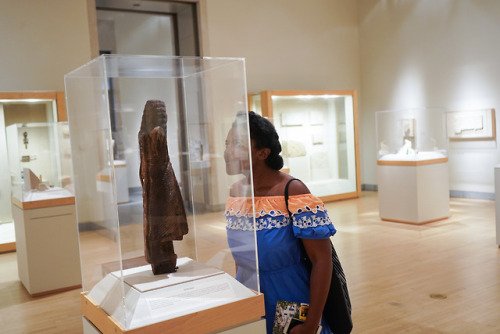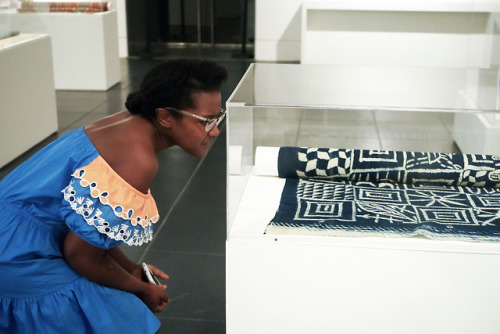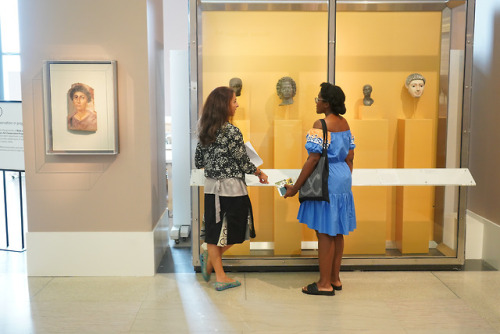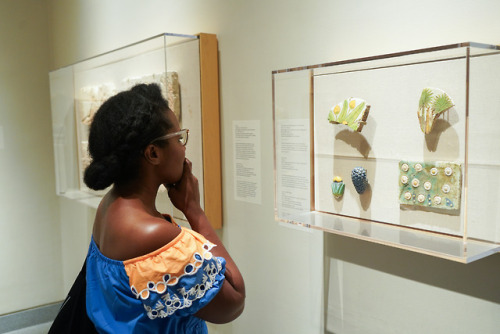Visual artist Temitayo Ogunbiyi visited the galleries and reserves of the Brooklyn Museum this summe
Visual artist Temitayo Ogunbiyi visited the galleries and reserves of the Brooklyn Museum this summer during her 2018 tenure as a Smithsonian Artist Research Fellow. Her research on botanicals and historic hair-based art will inform upcoming projects in the US and Nigeria. Here, she reflects on her experience at the Museum. Untidy hems can unnerve me, especially if there is any contrast between the thread and fabric. I look at things closely—from hairs of brush strokes to gradients within pencil marks. I’m usually searching for repeated shapes, techniques, and patterns. Through similar objects, I connect my studio practice to my life. So doing, I link seemingly disparate works. And in the process, I welcome the opportunity to confront boundaries of time and place. These often structure academia and guide institutions.My Brooklyn Museum visit began in the Egyptian collection. The texture of braided human hair extensions carbon dated to ca. 2114-1502 B.C.E. took me to two memories. The first was Halloween, over two decades ago, when I dressed up as Cleopatra. I sported (awful) thick eyeliner and synthetic, braided hair extensions. A stylist melted their ends to hold the strands together. The Egyptian extensions also reminded me of today’s crocheted, braided attachments. Someone was smart for coming up with those. Or was the inventor smart enough to bring back something Egyptian?I looked at several nineteenth-century Lei Niho Palaoa Hawaiian necklaces of human hair. And I recall Victorian Hair work, a concurrent craft with molded human hair. And I remember my Hawaiian neighbor across the street. Her hair touched the ground as she walked. Then, there is the numb feeling in my neck, when I was 19 years old. A young boy in Ibadan, Nigeria added what felt like 1 million braids of synthetic extensions to my hair. Those extensions were uniform, like the Lei Niho Palaoa, and a pain to take out.Next is the Coastal Wari wig headdress from present-day Peru. The wig dates to 600-1000 C.E.—and talk about something being in pristine condition! Its cotton fibers wrapped around human hair remind me, again, of Victorian Hair work. The technique is also in threading hairstyles that were once popular in Nigeria. I have been building a relationship between the two. Stacked colored threads in the headdress, are against the chocolate brown hair. It evokes friendship bracelets that I made when I was much younger. I’d tape colored thread to brown, faux leather seats in the yellow school buses that took me to and from school.Then there is the Karamojong mudpack coiffure. At once it is a fabulous headdress, a sculpture, and a cluster of July 4th fireworks. It is also the collection of lichens from Jamaica that I studied this summer in Washington, D.C. . I remember of Somi. She is my dear New York-based, Ugandan and Rwandan friend. How transnational can a life today be? She just left Lagos. And here, in Brooklyn, I’m looking at something collected in Uganda, and now housed in New York.With these observations, I try to think about what I see because of what I’ve seen. The challenge is to free myself of my biased views. I seek to do this by embracing tangents to build new, untidy narratives. These aim to highlight a willingness to celebrate different contexts. This matters, especially today when divide, ignorance and intolerance are trending.Posted by Temitayo Ogunbiyi -- source link
#bkmegyptianart#bkmafricanart#artist#artist visist#brooklyn museum#african art#hair#art#thread#fabric#egyptia#extensions#braids#hawaiian#necklace#nigeria#headdress#peru#wari#karamojong#mudpack#coiffure#sculptuer#firework#brooklyn#nyc



